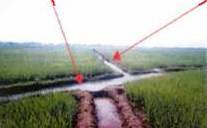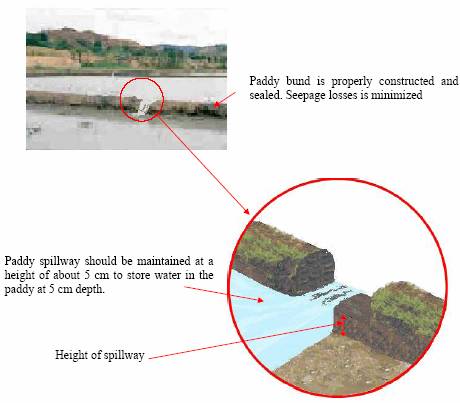|
|
|
Water management |
|
||||||||
|
|
|
|
|
||||||||
|
|
|
Building canals and bunds to control the water |
|
||||||||
|
|
|
|
|
||||||||
|
|
|
Explain how irrigation and drainage canals and paddy bund (dike) & spillway management improve your water management |
|
||||||||
|
|
|
Why do you need control of the water in the field?
Good water control is the most important practice that determines the efficiency of all other production inputs such as nutrients, herbicide, pesticide, farm machines, etc in rice farming. So if you have poor water control in the fields, all the other operations on the field will become more difficult!
What are the different ways to irrigate the fields?
Usually irrigation is done using one of the following methods:
--> In most cases, the SSC or AWD method needs less water than CSF!
|
|
||||||||
|
|
|
How can you control water use with canals and bunds?
At this moment, many rice farmers in irrigated areas are unable to effectively control water in their farms. This is often because of poor irrigation and drainage facilities and inefficient management of bunds (dikes)! Building and maintaining canals and bunds around the fields is essential for proper water management.
1. Build canals for irrigation and drainage The practice of adding or removing water from the paddy field in most irrigated rice areas is from paddy to paddy. Except for some small and low lying areas, drainage canals are often not there.
To effectively control and regulate water, on-farm ditches (=irrigation and drainage canals) must be provided to allow the delivery and application of water paddy by paddy. This will also minimize deep percolation losses within the farm.
|
|
||||||||
|
|
|
|
|
||||||||
|
|
|
2. Build bunds (dikes) and manage the spillways The control, conservation and management of water in the paddy field is best done by constructing bunds (or dikes) that are well compacted and sealed of cracks, rat holes, etc. This will minimize water losses through seepage (particularly in sloping lands). Paddy bunds that are loosely constructed and not properly sealed will enhance seepage water losses.
The depth of water stored and maintained in a paddy is controlled and regulated by properly adjusting the spillway height. The recommended spillway height is 5 cm to be able to store the same depth of water. |
|
||||||||
|
|
|
||||||||||
|
|
|
It should be emphasized that in the wet (or rainy) seasons this spillway height of 5 cm should be maintained to ensure sufficient storage capacity of the paddy.
However, when irrigating the field during rainless days, the depth of water applied must be shallow (1 cm or less) to provide freeboard for the storage of rainwater. Freeboard refers to the difference between the spillway height and the depth of water in the paddy.
A farmer checking the spillway in the bund. |
|
||||||||
Next lesson |
|
We will show how water management can be improved during land preparation. |
|
||||||||






